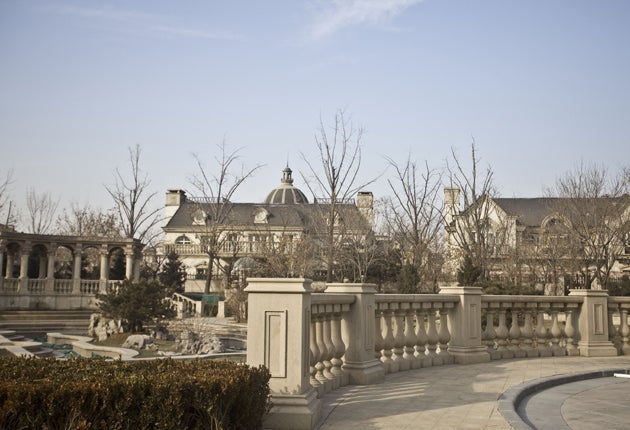French luxury tells a tale of China's haves and have-nots
Communist nation's new rich lavish millions on luxury homes inspired by Europe

Your support helps us to tell the story
From reproductive rights to climate change to Big Tech, The Independent is on the ground when the story is developing. Whether it's investigating the financials of Elon Musk's pro-Trump PAC or producing our latest documentary, 'The A Word', which shines a light on the American women fighting for reproductive rights, we know how important it is to parse out the facts from the messaging.
At such a critical moment in US history, we need reporters on the ground. Your donation allows us to keep sending journalists to speak to both sides of the story.
The Independent is trusted by Americans across the entire political spectrum. And unlike many other quality news outlets, we choose not to lock Americans out of our reporting and analysis with paywalls. We believe quality journalism should be available to everyone, paid for by those who can afford it.
Your support makes all the difference.They made a serious amount of money in the booming China of the Noughties, and now it is time for their habitat to match. So why not a plush villa in French chateau style, a few minutes from Beijing airport?
"Construct a legend of fortune, steer the world's power" is what the glossy brochure tells you to do, and why not, the wealthy Chinese entrepreneur might say, passing through rows of mini-chateaux replete with balconies, gables, elaborately tiled roofs, all oozing conspicuous consumption.
As the rest of the world reels from the lingering effects of the credit crunch, China is undergoing a property boom. All over the country they are building slightly alarming neo-Gothic, neo-Tudor, neo-classical piles as the communist nation's super-rich hunger for the look of a European pad combined with the luxury of an Asian high-end villa.
At the Palais de Fortune development, houses cost up to £5.5m each. They are generally sold long before they are built to Chinese buyers, either from the mainland or from Hong Kong. Inside, the compound feels like another planet, as you pass golden golf carts with badges on the bonnet reminiscent of Rolls-Royce's Silver Lady. The villas are an incongruous vision of European elegance amid the more typical Beijing suburban features of flat-bed tricycles and barely paved dirt roads.
"The first two phases are all sold out, and we have started working on phase three," said Tang Ming, deputy marketing director for the development. "The houses run between 43 million yuan (£3.9m) and 63 million yuan (£5.7m) and tend to be bought by Chinese buyers – from Hong Kong and Malaysia, but mostly the mainland, from Wenzhou and Shanghai and Beijing. They are bought by successful people who are busy and want to be near the airport."
The first two phases involved a total of 63 houses, while the third phase will have 25, of which all but six have been sold from the plans.
Shanghai is even crazier. Last month, a 700 sq m villa at Forbes Park estate in the suburb of Gubei was sold to an anonymous buyer for 190,000 yuan (£17,000) per sq m – a total of £11.9m. This is a record price in China's financial capital and nearly double the previous square metre price paid for a flat at the Tomson Riviera apartments in the Lujiazui financial centre of Pudong district.
"The units are too expensive for most Chinese, but not for those who are used to luxury accommodation and high living overseas," Xue Jianxiong, an analyst, told the China Daily newspaper.
The wealth gap between rich and poor is growing, and there is a certain amount of resentment around about the prices some of these villas are fetching. While the über -wealthy are splashing the cash and taking advantage of low interest rates, a recent report by the Chinese Academy of Social Sciences showed more than 80 per cent of urban Chinese cannot afford to buy homes.
Join our commenting forum
Join thought-provoking conversations, follow other Independent readers and see their replies
Comments